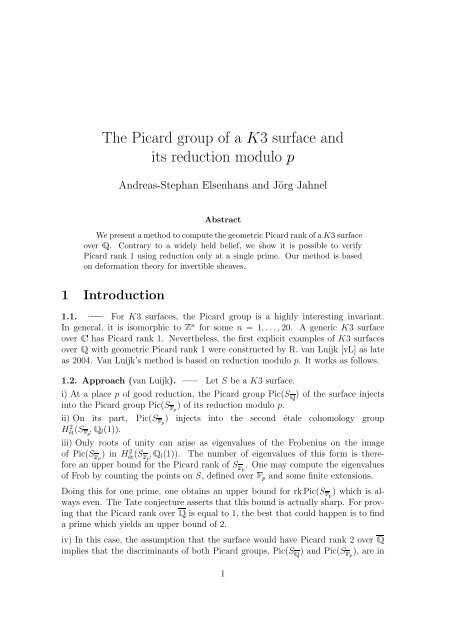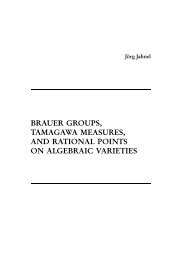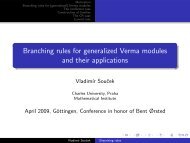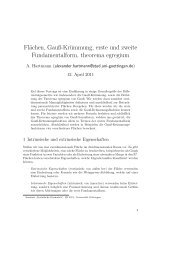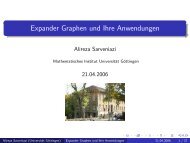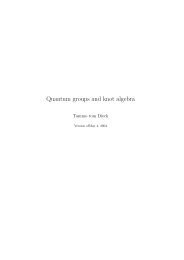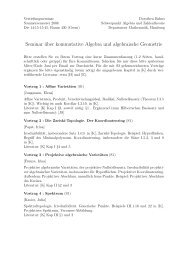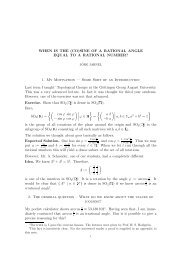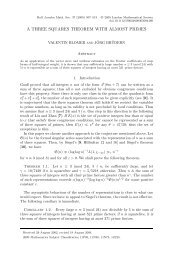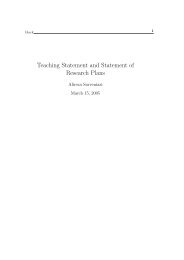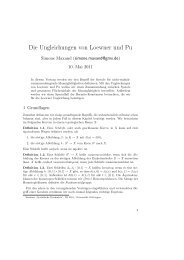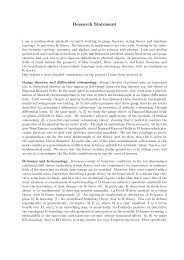The Picard group of a K3 surface and its reduction modulo p
The Picard group of a K3 surface and its reduction modulo p
The Picard group of a K3 surface and its reduction modulo p
Create successful ePaper yourself
Turn your PDF publications into a flip-book with our unique Google optimized e-Paper software.
<strong>The</strong> <strong>Picard</strong> <strong>group</strong> <strong>of</strong> a <strong>K3</strong> <strong>surface</strong> <strong>and</strong><br />
<strong>its</strong> <strong>reduction</strong> <strong>modulo</strong> p<br />
Andreas-Stephan Elsenhans <strong>and</strong> Jörg Jahnel<br />
Abstract<br />
We present a method to compute the geometric <strong>Picard</strong> rank <strong>of</strong> a <strong>K3</strong> <strong>surface</strong><br />
overÉ. Contrary to a widely held belief, we show it is possible to verify<br />
<strong>Picard</strong> rank 1 using <strong>reduction</strong> only at a single prime. Our method is based<br />
on deformation theory for invertible sheaves.<br />
1 Introduction<br />
1.1. –––– For <strong>K3</strong> <strong>surface</strong>s, the <strong>Picard</strong> <strong>group</strong> is a highly interesting invariant.<br />
In general, it is isomorphic ton for some n = 1, . . .,20. A generic <strong>K3</strong> <strong>surface</strong><br />
overhas <strong>Picard</strong> rank 1. Nevertheless, the first explicit examples <strong>of</strong> <strong>K3</strong> <strong>surface</strong>s<br />
overÉwith geometric <strong>Picard</strong> rank 1 were constructed by R. van Luijk [vL] as late<br />
as 2004. Van Luijk’s method is based on <strong>reduction</strong> <strong>modulo</strong> p. It works as follows.<br />
1.2. Approach (van Luijk). —– Let S be a <strong>K3</strong> <strong>surface</strong>.<br />
i) At a place p <strong>of</strong> good <strong>reduction</strong>, the <strong>Picard</strong> <strong>group</strong> Pic(SÉ) <strong>of</strong> the <strong>surface</strong> injects<br />
into the <strong>Picard</strong> <strong>group</strong> ) <strong>of</strong> <strong>its</strong> <strong>reduction</strong> <strong>modulo</strong> p.<br />
Pic(Sp<br />
ii) On <strong>its</strong> part, ) injects into the second étale cohomology <strong>group</strong><br />
Pic(Sp<br />
,Él(1)). (Sp<br />
H 2 ét<br />
iii) Only roots <strong>of</strong> unity can arise as eigenvalues <strong>of</strong> the Frobenius on the image<br />
<strong>of</strong> Pic(Sp ) in H2 ét ,Él(1)). <strong>The</strong> number <strong>of</strong> eigenvalues <strong>of</strong> this form is therefore<br />
an upper bound for the <strong>Picard</strong> rank <strong>of</strong> . One may compute the eigenvalues<br />
Sp<br />
(Sp<br />
<strong>of</strong> Frob by counting the points on S, defined overp <strong>and</strong> some finite extensions.<br />
Doing this for one prime, one obtains an upper bound for rk ) which is always<br />
even. <strong>The</strong> Tate conjecture asserts that this bound is actually sharp. For prov-<br />
Pic(Sp<br />
ing that the <strong>Picard</strong> rank overÉis equal to 1, the best that could happen is to find<br />
a prime which yields an upper bound <strong>of</strong> 2.<br />
iv) In this case, the assumption that the <strong>surface</strong> would have <strong>Picard</strong> rank 2 overÉ<br />
implies that the discriminants <strong>of</strong> both <strong>Picard</strong> <strong>group</strong>s, Pic(SÉ) <strong>and</strong> ), are in<br />
Pic(Sp<br />
1
the same square class. Note here that <strong>reduction</strong> <strong>modulo</strong> p respects the intersection<br />
product.<br />
v) To obtain a contradiction, one combines information from two primes. It may<br />
happen that one has a rank bound <strong>of</strong> 2 at both places but different square classes<br />
for the discriminant do arise. <strong>The</strong>n, these data are incompatible with <strong>Picard</strong> rank 2<br />
overÉ.<br />
1.3. <strong>The</strong> improvement. –––– Approach 1.2 accepts the possibility that<br />
Pic(SÉ) ⊂ ) might be a proper sublattice <strong>of</strong> full rank. If that occurred then<br />
Pic(Sp<br />
one knows at least that the two discriminants differ by a perfect square. This is a<br />
st<strong>and</strong>ard observation from the theory <strong>of</strong> lattices.<br />
We will show in this article that such provisions need not be made. From the<br />
technical point <strong>of</strong> view, our main result states that, at least for p ≠ 2, the quotient<br />
Pic(Sp )/ Pic(SÉ) is always torsion-free. This is true actually in much more generality<br />
than just for <strong>K3</strong> <strong>surface</strong>s. It follows in a rather straightforward manner from<br />
deformation theory, a tool developed by A. Grothendieck <strong>and</strong> M. Artin in the sixties<br />
<strong>of</strong> the last century. To be precise, our result is as follows.<br />
1.4. <strong>The</strong>orem. –––– Let p ≠ 2 be a prime number <strong>and</strong> X be a scheme proper<br />
<strong>and</strong> flat over. Suppose that the special fiber X p is non-singular.<br />
<strong>The</strong>n, the specialization homomorphism Pic(XÉ) → ) has a torsion-free cokernel.<br />
Pic(Xp<br />
1.5. Remark. –––– We will prove this theorem in 3.4. As an application, one may<br />
prove rk Pic(SÉ) = 1 for a <strong>K3</strong> <strong>surface</strong> S using <strong>its</strong> <strong>reduction</strong> only at a single prime.<br />
This works as follows.<br />
Approach. Let a <strong>K3</strong> <strong>surface</strong> S be given.<br />
i) For a prime p ≠ 2 <strong>of</strong> good <strong>reduction</strong>, perform steps i), ii) <strong>and</strong> iii) as in 1.2.<br />
<strong>The</strong>reby, the hope is to prove rk ) ≤ 2. Further, compute the discriminant<br />
Pic(Sp<br />
giving two explicit generators. Alternatively, one might use the Artin-Tate formula.<br />
ii) Assume rk Pic(SÉ) = 2. <strong>The</strong>n, according to <strong>The</strong>orem 1.4, every invertible sheaf<br />
on lifts to SÉ. Use <strong>reduction</strong> theory <strong>of</strong> binary quadratic forms or explicit<br />
Sp<br />
arguments to estimate the degree <strong>of</strong> a hypothetical effective divisor. Finally, use<br />
Gröbner bases to verify that such a divisor does not exist.<br />
1.6. Example. –––– Consider the <strong>K3</strong> <strong>surface</strong> S overÉ, given by<br />
w 2 = x 5 y + x 4 y 2 + 2x 3 y 3 + x 2 y 4 + xy 5 + 4y 6 + 2x 5 z + 2x 4 z 2 + 4x 3 z 3 + 2xz 5 + 4z 6 .<br />
<strong>The</strong>n, rk Pic(SÉ) = 1.<br />
2
Pro<strong>of</strong>. For the <strong>reduction</strong> <strong>of</strong> S at the prime 5, one sees that the branch locus has<br />
a tritangent line given by z − 2y = 0. It meets the branch locus at (1 : 0 : 0),<br />
(1 : 3 : 1), <strong>and</strong> (0 : 1 : 2).<br />
<strong>The</strong> numbers <strong>of</strong> points over5d are, in this order, 41, 751, 15 626,<br />
392 251, 9 759 376, 244 134 376, 6 103 312 501, 152 589 156 251, 3 814 704 296 876, <strong>and</strong><br />
95 367 474 609 376. Thus, the traces <strong>of</strong> the Frobenius on Hét 2 ,Él) are 15, 125, 0,<br />
(S5<br />
1 625, −6 250, −6 250, −203 125, 1 265 625, 7 031 250, <strong>and</strong> 42 968 750. Algorithm 23<br />
<strong>of</strong> [EJ1] shows that the sign in the functional equation is positive. <strong>The</strong> characteristic<br />
polynomial <strong>of</strong> the Frobenius is therefore completely determined. For <strong>its</strong> decomposition<br />
into prime polynomials, we find (after scaling)<br />
(t − 5) 2 (t 20 − 5 t 19 − 25 t 18 + 250 t 17 − 250 t 16 − 1 875 t 15 + 12 500 t 14 − 31 250 t 13<br />
− 156 250 t 12 + 390 625 t 11 + 5 859 375 t 10 + 9 765 625 t 9 − 97 656 250 t 8<br />
− 488 281 250 t 7 + 4 882 812 500 t 6 − 18 310 546 875 t 5 − 61 035 156 250 t 4<br />
+ 1 525 878 906 250 t 3 − 3 814 697 265 625 t 2 − 19 073 486 328 125 t<br />
+ 95 367 431 640 625).<br />
This shows rk ) ≤ 2. Pic(S5<br />
<strong>The</strong> spl<strong>its</strong> <strong>of</strong> the pull-back <strong>of</strong> the tritangent line are explicit generators<br />
for ). Such a split l, being a projective line, has self-intersection number<br />
Pic(S5<br />
l 2 = −2. Further, lh = 1 for h the pull-back <strong>of</strong> a line. If we had rk Pic(SÉ) = 2<br />
then the invertible sheaf O(l) would lift to SÉ. We had a divisor L on SÉsuch<br />
that HL = 1 <strong>and</strong> L 2 = −2. By [BPV, Ch.VIII, Proposition 3.6.i], such a divisor is<br />
automatically effective.<br />
HL = 1 shows that L is obtained from a line on P 2 , the pull-back <strong>of</strong> which spl<strong>its</strong><br />
into two components. This is possible only for a tritangent line <strong>of</strong> the branch locus.<br />
[EJ1, Algorithm 8] shows, however, that such a tritangent line does not exist. □<br />
2 <strong>The</strong> sequence <strong>of</strong> the <strong>Picard</strong> lattices<br />
2.1. Remark. –––– <strong>The</strong> pro<strong>of</strong> <strong>of</strong> <strong>The</strong>orem 1.4 relies on deformation-theoretic<br />
methods. For <strong>K3</strong> <strong>surface</strong>s <strong>and</strong> prime-to-p torsion, one could have used étale<br />
cohomology which appears to be more natural.<br />
In fact, to show Pic(Xp )/ Pic(XÉ) has no l-torsion, it is sufficient to consider<br />
)⊗l/ Pic(XÉ)⊗l. But Pic(Xp Pic(Xp )⊗l ⊆ Hét 2 ,l(1)) which,<br />
(Xp<br />
by st<strong>and</strong>ard comparison theorems, is isomorphic to Hsing(X(),)⊗l. 2 On the<br />
other h<strong>and</strong>, Pic(XÉ) ∼ = Pic(X). Finally, Hsing 2 (X(),)/ Pic(X) is torsion-free<br />
according to the Lefschetz (1, 1)-theorem.<br />
2.2. Notation. –––– Let X be ap-scheme. <strong>The</strong>n, we will write X p for the<br />
special fiber <strong>and</strong>, more generally, X p n := X × Specp Spec/p n. Finally, let ̂X be<br />
the formal scheme obtained by completing X along (p).<br />
3
2.3. Lemma. –––– Let p ≠ 2 be a prime number <strong>and</strong> X ap-scheme which is<br />
Noetherian <strong>and</strong> separated. Denote by P ⊆ Pic(X p ) the subset <strong>of</strong> all invertible sheaves<br />
allowing a lift as an invertible sheaf on ̂X.<br />
<strong>The</strong>n, Pic(X p )/P is torsion-free.<br />
Pro<strong>of</strong>. First step: Preliminaries.<br />
Assume, to the contrary, that Pic(X p )/P has torsion. <strong>The</strong>n, there are a prime<br />
number l <strong>and</strong> an invertible sheaf L ∈ Pic(X p )\P such that L ⊗l ∈ P. This means<br />
that L ⊗l lifts to ̂X but L does not.<br />
By [Ha, Proposition II.9.6], an invertible sheaf on ̂X is the same as an inverse<br />
system (L n ) n <strong>of</strong> invertible sheaves L n ∈ Pic(X p n) such that L n+1 | Xp n = L n for<br />
all n. Hence, we have an invertible sheaf L n ∈ Pic(X p n) not lifting to X p n+1 but<br />
such that Ln ⊗l lifts to X p N for any N.<br />
Second step: Obstructions.<br />
In the short exact sequence<br />
0 −→ K −→ O ∗ X p n+1 −→ O ∗ X p n<br />
−→ 0 ,<br />
we have O Xp<br />
∼ = K via the exponential map x ↦→ 1 + p n x (mod p n+1 ). Thus, there<br />
is the exact cohomology sequence<br />
H 1 (X p , O Xp ) −→ Pic(X p n+1) −→ Pic(X p n) −→ H 2 (X p , O Xp ) .<br />
As L n does not lift to X p n+1, it defines a non-zero class cl(L n ) ∈ H 2 (X p , O Xp ).<br />
This is a p-torsion <strong>group</strong> as the sheaf O Xp is annihilated by p. Hence,<br />
cl(L ⊗l<br />
n ) = l·cl(L n ) ≠ 0<br />
for l ≠ p. This means that Ln<br />
⊗l does not lift to X p n+1, either, which is a contradiction.<br />
For l ≠ p, the pro<strong>of</strong> is complete.<br />
Third step: <strong>The</strong> case l = p.<br />
Here, we have to describe the obstruction more concretely. Let (U i ) i be an open<br />
cover <strong>of</strong> X p which trivializes the sheaf L n . Choose isomorphisms L n | Ui<br />
∼ = OXp n | Ui .<br />
<strong>The</strong>n, L n is described by transition functions g ij ∈ O Xp n(U i ∩ U j ) fulfilling<br />
g ij g jk = g ik on the triple intersections. <strong>The</strong> class cl(L n ) is given by the cocycle<br />
(c ijk ) ijk such that<br />
˜g ij˜g jk˜g −1<br />
ik = 1 + pn c ijk (mod p n+1 )<br />
for ˜g lm a lift <strong>of</strong> g lm to O Xp n+1.<br />
For Ln<br />
⊗p , the transition functions are g p ij . Further, there is the congruence<br />
p<br />
˜g ij˜gp<br />
jk˜g−p<br />
ik = 1 + pn+1 c ijk (mod p n+2 )<br />
which, as p > 2, is valid for every n ≥ 1. By assumption, Ln<br />
⊗p lifts to X p n+2.<br />
Hence, (c ijk ) ijk defines the zero class in H 2 (X p , O Xp ). But then, L n lifts to X p n+1,<br />
a contradiction.<br />
□<br />
4
2.4. Remark. –––– For p = 2, the same argument shows that Pic(X 2 )/P may<br />
only have 2-power torsion.<br />
2.5. –––– To illustrate the effect <strong>of</strong> the obstructions, suppose that Pic(X p ) =n<br />
<strong>and</strong> H 2 (X p , O Xp ) ∼ =p. <strong>The</strong>n, the lattices Λ i := Pic(X p i) form a system {Λ i }<br />
such that<br />
. . . ⊆ Λ i ⊆ . . . ⊆ Λ 2 ⊆ Λ 1 ,<br />
Λ i ⊆ Λ i−1 is always <strong>of</strong> index 1 or p, <strong>and</strong> L<br />
i∈Æ<br />
⊗p ∈ Λ i if <strong>and</strong> only if L ∈ Λ i−1 .<br />
According to Lemma 2.7 below, the system {Λ i ⊗p} i∈Æis isomorphic to<br />
{p⊕ · · · ⊕p⊕p ip} i∈Æ. I.e., there is a linear functional<br />
H : Pic(X p ) =n →p,<br />
(x 1 , . . .,x n ) ↦→ a 1 x 1 + · · · + a n x n<br />
with coefficients a 1 , . . .,a n ∈p such that, for L ∈ Pic(X p ) arbitrary, p i |H(L ) if<br />
<strong>and</strong> only if L lifts to Pic(X p i).<br />
H somehow collects all the obstruction maps into a single homomorphism. Further,<br />
H(L ) = 0 if <strong>and</strong> only if L ∈ P. This shows again that Pic(X p )/P ֒→p is<br />
torsion-free.<br />
2.6. Remark. –––– This formulation also indicates that it is difficult to show<br />
rkP ≤ rk Pic(X p ) − 2. For this, one had to ensure that the-rank <strong>of</strong> im H is at<br />
least 2. But this is impossible knowing only p-adic approximations <strong>of</strong> a 1 , . . .,a n .<br />
2.7. Lemma. –––– Let {Λ i } i∈Æbe a sequence <strong>of</strong> p-adic lattices such that<br />
i) Λ i+1 ⊂ Λ i ,<br />
ii) Λ i /Λ i+1 =/p,<br />
iii) x ∈ Λ i \Λ i+1 =⇒ px ∈ Λ i+1 \Λ i+2 .<br />
<strong>The</strong>n, there exists a basis (b 1 , . . .,b n ) <strong>of</strong> Λ 1 such that Λ i = 〈b 1 , . . .,b n−1 , p i−1 b n 〉.<br />
Pro<strong>of</strong> (cf. [We]). We first observe that Λ 1 /Λ i<br />
∼ =/p i−1. Indeed, the quotient<br />
Λ 1 /Λ i is precisely <strong>of</strong> order p i−1 . Further, for x ∈ Λ 1 \Λ 2 , we find px ∈ Λ 2 \Λ 3<br />
<strong>and</strong>, finally, p i−2 x ∈ Λ i−1 \Λ i . In particular, we see that Λ 0 /Λ i has an element <strong>of</strong><br />
order p i−1 .<br />
Let now i be fixed. By the elementary divisor theorem, there exists a basis<br />
(b 1 , . . .,b n ) <strong>of</strong> Λ 0 such that (p e 1<br />
b 1 , . . ., p en b n ) is a basis <strong>of</strong> Λ i . As this yields<br />
Λ 1 /Λ i<br />
∼ =/p e 1×· · ·×/p en, we may conclude e 1 = · · · = e n−1 = 0 <strong>and</strong> e n = i−1.<br />
<strong>The</strong> only lattices between Λ 0 <strong>and</strong> Λ i are 〈b 1 , . . .,b n−1 , p j b n 〉 for j = 1, . . .,i − 2.<br />
Thus, we have shown the assertion for a finite chain <strong>of</strong> lattices.<br />
To prove it for the infinite sequence, we observe that the space <strong>of</strong> all bases <strong>of</strong> Λ 1 is<br />
compact in the p-adic topology. For every i ∈Æ, there is a basis B (i) = (b (i)<br />
1 , . . ., b (i)<br />
<strong>of</strong> Λ 1 having the desired property for the finite subsequence Λ 1 , . . ., Λ i . Consider the<br />
limit (b 1 , . . .,b n ) <strong>of</strong> a convergent subsequence <strong>of</strong> {B (i) } i∈Æ.<br />
We claim that (b 1 , . . ., b n−1 , p i−1 b n ) is a basis for Λ i . Indeed, (b 1 , . . .,b n−1 , p i−1 b n )<br />
is arbitrarily close to a basis which completes the pro<strong>of</strong>.<br />
□<br />
5<br />
n )
3 <strong>The</strong> quotient )/ Pic(XÉ)<br />
Pic(Xp<br />
3.1. Sublemma. –––– Let p be a prime number <strong>and</strong> X be ap-scheme which<br />
is proper <strong>and</strong> flat. Suppose that the generic fiber X η is connected <strong>and</strong> the special<br />
fiber X p is non-singular.<br />
<strong>The</strong>n, X p is irreducible.<br />
Pro<strong>of</strong>. <strong>The</strong> function field K := Γ(X η , O Xη ) is a finite extension <strong>of</strong>Ép. Further,<br />
O := Γ(X, O X ) is a finitep-algebra being an integral domain with quotient<br />
field K. Clearly, O/pO is contained in Γ(X p , O Xp ). But, according to the assumption,<br />
the latter does not have nilpotent elements other than zero. Hence, p generates<br />
the maximal ideal <strong>of</strong> O. This means, K/Ép is necessarily unramified <strong>and</strong> O = O K is<br />
<strong>its</strong> ring <strong>of</strong> integers. Stein factorization provides us with a morphism X → Spec O K<br />
with connected fibers. From this, we immediately see that X p is connected. As X p<br />
is non-singular, this is enough for irreducibility.<br />
□<br />
3.2. Lemma. –––– Let p ≠ 2 be a prime number <strong>and</strong> X be ap-scheme which is<br />
proper <strong>and</strong> flat. Suppose that the special fiber X p is non-singular.<br />
<strong>The</strong>n, the specialization homomorphism sp: Pic(X η ) → Pic(X p ) from the generic<br />
fiber has a torsion-free cokernel.<br />
Pro<strong>of</strong>. As each connected component may be treated separately, we assume without<br />
restriction that X is connected. Further, the assumption implies that X is nonsingular.<br />
Hence, X is actually irreducible. This implies that X η is irreducible, too.<br />
Finally, we conclude irreducibility <strong>of</strong> X p from Sublemma 3.1.<br />
<strong>The</strong>re is a specialization map Pic(X η ) → Pic(X) given by taking the Zariski<br />
closure in X <strong>of</strong> a Weil divisor on X η . This map is injective as the restriction forms<br />
a section to it. It is a surjection, too, as the only vertical divisors are principal,<br />
associated to the powers <strong>of</strong> (p).<br />
Further, by A. Grothendieck’s existence theorem [EGA III, Corollaire (5.1.6)],<br />
one has Pic(X) = Pic( ̂X). <strong>The</strong> assertion now follows from Lemma 2.3. □<br />
3.3. Corollary. –––– Let p ≠ 2 be a prime number <strong>and</strong> X be ap-scheme<br />
which is proper <strong>and</strong> flat. Suppose that the special fiber X p is non-singular. Further,<br />
let K/Ép be an unramified field extension <strong>and</strong> denote the residue field <strong>of</strong> K<br />
by k.<br />
<strong>The</strong>n, the cokernels <strong>of</strong> the specialization homomorphisms<br />
i) sp K : Pic(X K ) → Pic(X k ),<br />
ii) : spÉnr<br />
p Pic(XÉnr ) → ), <strong>and</strong><br />
p<br />
Pic(Xp<br />
iii) : ) → )<br />
spÉp<br />
Pic(XÉp<br />
Pic(Xp<br />
are torsion-free.<br />
Pro<strong>of</strong>. i) Apply Lemma 3.2 to the fiber product X × SpecpSpec O K .<br />
6
ii) As the filtered direct limit functor is exact, the desired cokernel is the same as<br />
lim<br />
−→ coker(sp K : Pic(X K ) → Pic(X k ))<br />
where K is running over the unramified extensions <strong>of</strong>Ép <strong>and</strong> k denotes the residue<br />
field <strong>of</strong> K. As all the cokernels are torsion-free, the assertion follows.<br />
iii) We claim that has the same image in ) as spÉnr. Let L ∈ ).<br />
spÉp<br />
Pic(Xp p<br />
Pic(XÉp<br />
<strong>The</strong> Galois <strong>group</strong> Γ := Gal(Ép/Énr<br />
p ) sends L to a finite orbit {L 1, . . .,L m }.<br />
<strong>The</strong> specializations <strong>of</strong> L 1 , . . ., L m in ) are all the same. <strong>The</strong>refore,<br />
Pic(Xp<br />
m·spÉp (L ) = spÉp (L ⊗m ) = spÉp (L 1⊗ · · · ⊗L m ) = spÉnr<br />
p (L 1⊗ · · · ⊗L m )<br />
since L 1 ⊗ · · · ⊗L m is Γ-invariant. Hence, m·spÉp<br />
torsion-free cokernel, we see that spÉp<br />
(L ) ∈ im spÉnr<br />
p , too.<br />
(L ) ∈ im spÉnr. As spÉnr<br />
p p<br />
has a<br />
□<br />
3.4. <strong>The</strong>orem. –––– Let p ≠ 2 be a prime number <strong>and</strong> X be a scheme proper<br />
<strong>and</strong> flat over. Suppose that the special fiber X p is non-singular.<br />
<strong>The</strong>n, the specialization homomorphism spÉ: Pic(XÉ) → ) has a torsionfree<br />
Pic(Xp<br />
cokernel.<br />
Pro<strong>of</strong>. <strong>The</strong>re is a canonical injection Pic(XÉ) ֒→ ). We have to show that<br />
Pic(XÉp<br />
both <strong>Picard</strong> <strong>group</strong>s have the same image under specialization to ). Pic(Xp<br />
For this, we switch at first to the scheme X Z for Z =[ 1 ] where m is an<br />
m<br />
integer divisible by all primes <strong>of</strong> bad <strong>reduction</strong> but not by p. Again, we may assume<br />
without restriction that X Z is connected. Further, by construction, X Z is nonsingular<br />
<strong>and</strong>, therefore, irreducible. By virtue <strong>of</strong> Sublemma 3.1, all the special<br />
fibers <strong>of</strong> X Z are irreducible.<br />
According to a theorem <strong>of</strong> Grothendieck (cf. [Kl, <strong>The</strong>orem 4.8]), the <strong>Picard</strong><br />
scheme Pic XZ /Z exists in this situation as a scheme, locally <strong>of</strong> finite type over Z.<br />
This means, we are given a morphism i: SpecÉp → Pic XZ /Z <strong>and</strong> have to show that<br />
there is a morphism SpecÉ→Pic XZ /Z such that the specializations <strong>modulo</strong> p are<br />
the same.<br />
Locally, near the image <strong>of</strong> i, we have an affine open subset U ∼ = Spec R ⊆ Pic XZ /Z<br />
for R a finitely generated Z-algebra. We are thus given a ring homomorphism<br />
ι: R →Ép. This actually maps R to O K for a suitable finite extension K/Ép.<br />
Unfortunately, as a Z-algebra, O K is not finitely generated. On the other h<strong>and</strong>,<br />
im ι =: S ⊂ O K is clearly a finitely generated Z-algebra. We fix a set <strong>of</strong> generators<br />
{T 1 , . . ., T n } <strong>of</strong> S.<br />
Preserving the induced homomorphism toq := O K /m K , our goal is to replace<br />
ι by a homomorphism to another subring S ′ ⊂ O K such that S is finite as<br />
a Z-module. For this, we will construct an algebra homomorphism ϕ: S → S ′ such<br />
that ν(x −ϕ(x)) ≥ 1 for every x ∈ S. Here, ν denotes the discrete valuation on O K .<br />
7
To perform this construction, we apply Noether normalization [ZS, Ch.V, §4,<br />
<strong>The</strong>orem8] to S ⊗É. This states that S ⊗Éis an integral extension <strong>of</strong> a polynomial<br />
ringÉ[X 1 , . . .,X k ] ⊆ S⊗É. We send X 1 , . . .,X k to elements <strong>of</strong> O K algebraic<br />
overÉsuch that ν(X i − ϕ(X i )) ≫ 0. <strong>The</strong>n, this extends to a homomorphism <strong>of</strong><br />
the whole <strong>of</strong> S⊗É. We claim that ν(T i − ϕ(T i )) ≥ 1 for i = 1, . . .,n. Indeed, as T i<br />
is integral overÉ[X 1 , . . .,X k , T 1 , . . ., T i−1 ], this follows from an iterated application<br />
<strong>of</strong> Hensel’s lemma in the form <strong>of</strong> [Na, Proposition 5.5].<br />
Since S is generated by T 1 , . . .,T n as a Z-algebra <strong>and</strong> ν(z) ≥ 0 for every z ∈ Z,<br />
we see that ν(x − ϕ(x)) ≥ 1 for every x ∈ S. This completes the pro<strong>of</strong>. □<br />
4 An explicit obstruction<br />
4.1. Proposition. –––– Let S be a <strong>K3</strong> <strong>surface</strong> <strong>of</strong> degree 2 overÉ, given explicitly<br />
by<br />
w 2 = f 6 (x, y, z)<br />
for f 6 ∈[x, y, z] <strong>of</strong> degree 6. Suppose, for a prime p ≠ 2, there is anp-rational<br />
tritangent line “l = 0” <strong>of</strong> the ramification locus <strong>of</strong> S p . Write l for a split <strong>of</strong> the<br />
pull-back <strong>of</strong> the tritangent.<br />
One has f 6 ≡ f 2 3 + lf 5 (mod p) for homogeneous forms f 3 , f 5 ∈[x, y, z]. Put<br />
G(x, y, z) := (f 6 − f 2 3 − lf 5 )/p .<br />
<strong>The</strong>n, the obstruction to lifting O(l) to S p 2 is ((−G) mod (p, l, f 3 , f 5 )).<br />
Pro<strong>of</strong>. First step. An affine open covering <strong>of</strong> S p .<br />
On S p , we have w 2 = f3 2 + lf 5 <strong>and</strong>, for h a quadric, w 2 = (f 3 + lh) 2 + lf 5 ′ where<br />
f 5 ′ := f 5 − 2f 3 h − lh 2 . On “l = 0”, f 3 <strong>and</strong> f 5 have no common zero as this would<br />
cause a singularity on S p . Hence, for a suitably chosen h, the three forms l, f 5 ,<br />
<strong>and</strong> f 5 ′ do not have a common zero. For this, it may be necessary to extend the<br />
ground field. <strong>The</strong> sets “l ≠ 0”, “f 5 ≠ 0”, <strong>and</strong> “f 5 ′ ≠ 0”, form an affine open covering<br />
<strong>of</strong> S p . We may extend them in the obvious manner to an affine open covering <strong>of</strong> S.<br />
Second step. <strong>The</strong> invertible sheaf O(5l).<br />
We start with O(5l) instead <strong>of</strong> O(l) as this will turn out to be easier. O(5l) is<br />
f5<br />
given by the rational functions 1 on “l ≠ 0”,<br />
3 f<br />
(w+f 3<br />
on “f<br />
) 5 5 5 ≠ 0”, <strong>and</strong><br />
′ 3<br />
(w+f 3 +lh) 5<br />
on “f 5 ′ ≠ 0”. Thus, the transition functions are<br />
f5<br />
3<br />
(w + f 3 ) = (w − f 3) 5<br />
,<br />
5 l 5 f5<br />
2<br />
(w + f 3 + lh) 5<br />
<strong>and</strong><br />
.<br />
f 5 ′ 3<br />
(w + f 3 ) 5 f ′ 5 3<br />
(w + f 3 + lh) 5 f 3 5<br />
= (w + f 3) 5 (w − f 3 − lh) 5<br />
l 5 f 3 5f ′ 5 2 ,<br />
8
Third step. <strong>The</strong> obstruction.<br />
We may lift the first <strong>and</strong> third transition functions naively. <strong>The</strong> middle one is a<br />
transition function between “f 5 ≠ 0” <strong>and</strong> “f ′ 5 ≠ 0” <strong>and</strong>, thus, must not have a pole<br />
at “l ≠ 0”. We lift (w + f 3 )(w − f 3 ) as lf 5 <strong>and</strong> obtain, in total,<br />
<strong>The</strong> product <strong>of</strong> the three lifts is<br />
[f 5 − h(w + f 3 )] 5<br />
f 3 5 f ′ 5 2 .<br />
(w − f 3 ) 5 [f 5 − h(w + f 3 )] 5 (w + f 3 + lh) 5<br />
l 5 f 5 5 f ′ 5 5 .<br />
Observe that, in the form described, the transition functions may be lifted even<br />
to the affine open subsets <strong>of</strong> S, not just to S p 2. Hence, the exponential <strong>of</strong> the<br />
obstruction for O(l) is (w−f 3)[f 5 −h(w+f 3 )](w+f 3 +lh)<br />
lf 5<br />
, also in the case that p = 5.<br />
f 5<br />
′<br />
Evaluating this expression, making use <strong>of</strong> the identity w 2 −f3 2 = lf 5 +pG, we end<br />
up with 1 + p G(f 5−hw−hf 3 −lh 2 )<br />
lf 5<br />
. <strong>The</strong>refore, the obstruction to lifting O(l) is given by<br />
f 5<br />
′<br />
the Čech cocycle G(f 5 − hw − hf 3 − lh 2 )<br />
.<br />
lf 5 f 5<br />
′<br />
Fourth step. Simplification.<br />
Any rational function having poles in only two <strong>of</strong> the three divisors considered is<br />
a Čech coboundary. Without changing the cohomology class, we may therefore<br />
add to the numerator forms being homogeneous <strong>of</strong> degree 11 <strong>and</strong> belonging to the<br />
ideal (l, f 5 , f 5).<br />
′<br />
On the line “l = 0”, f 5 <strong>and</strong> f 5 ′ have no zeroes in common. Thus, they are coprime<br />
in the graded ringp[x, y, z]/(l). Consequently, f 5 <strong>and</strong> f 5 ′ already generate the full<br />
10-dimensional space <strong>of</strong> forms <strong>of</strong> degree 9. Even more, they must generate the space<br />
−Ghw<br />
<strong>of</strong> forms <strong>of</strong> degree 11. This shows that we may simplify the Čech cocycle to<br />
lf 5<br />
.<br />
f 5<br />
′<br />
Hence, the obstruction to lifting O(l) is ((−Gh) mod (p, l, f 5 , f 5 ′ )). <strong>The</strong> ideal is<br />
the same as (p, l, hf 3 , f 5 ). Thus, the question is whether ((−Gh) mod (p, l)) is a<br />
combination <strong>of</strong> hf 3 <strong>and</strong> f 5 . As, on the line “l = 0” on S p , h <strong>and</strong> f 5 have no common<br />
zeroes, they are coprime. ((−Gh) mod (p, l)) must be a combination <strong>of</strong> hf 3 <strong>and</strong> hf 5 .<br />
We may, as well, consider ((−G) mod (p, l, f 3 , f 5 )).<br />
□<br />
4.2. Example. –––– Let S be a <strong>K3</strong> <strong>surface</strong> overÉgiven by w 2 = f 6 (x, y, z).<br />
Suppose<br />
f 6 (x, y, z) ≡ x 6 + 2x 5 z + 2x 4 y 2 + 2x 4 z 2 + 2x 3 y 3 + 2x 3 z 3<br />
+ 2x 2 y 4 + 2x 2 y 3 z + x 2 z 4 + xy 3 z 2 + 2xz 5 + y 6 (mod 3) .<br />
9
Assume further that the coefficient <strong>of</strong> y 2 z 4 is not divisible by 9.<br />
<strong>The</strong>n, rk Pic(SÉ) = 1.<br />
Pro<strong>of</strong>. A direct calculation shows that, <strong>modulo</strong> 3, the right h<strong>and</strong> side is f3 2 + xf 5<br />
for f 3 = 2x 3 + 2x 2 z + xz 2 + 2y 3 <strong>and</strong> f 5 = 2x 3 y 2 + x 2 z 3 + 2xy 4 + 2z 5 . Thus, the<br />
branch locus <strong>of</strong> S 3 has a tritangent line given by x = 0.<br />
<strong>The</strong> numbers <strong>of</strong> points over3 d are, in this order, 19, 127, 676, 6 751, 58 564,<br />
532 414, 4 791 232, 43 038 703, 387 383 311, <strong>and</strong> 3 486 675 052. For the decomposition<br />
<strong>of</strong> the characteristic polynomial <strong>of</strong> the Frobenius, we find<br />
(t − 3) 2 (t 20 − 3 t 19 − 9 t 18 + 72 t 17 − 8 1t 16 − 324 t 15 + 1 458 t 14 − 2 916 t 13<br />
+ 4 374 t 12 + 26 244 t 11 − 137 781 t 10 + 236 196 t 9 + 354 294 t 8 − 2 125 764 t 7<br />
+ 9 565 938 t 6 − 19 131 876 t 5 − 43 046 721 t 4 + 344 373 768 t 3 − 387 420 489 t 2<br />
− 1 162 261 467 t + 348 6784 401).<br />
This shows rk Pic(S3 ) ≤ 2.<br />
Let l be a split <strong>of</strong> the pull-back <strong>of</strong> the tritangent line. We have to show that<br />
the obstruction to lifting O(l) is non-zero. For this, we observe that x, f 3 , <strong>and</strong> f 5<br />
do not generate the monomial y 2 z 4 . However, G contains this monomial by <strong>its</strong><br />
very definition.<br />
□<br />
4.3. Example. –––– Consider the <strong>K3</strong> <strong>surface</strong> S overÉ, given by w 2 = f 6 (x, y, z)<br />
for<br />
f 6 (x, y, z) = 4x 6 + 2x 5 y + 12x 5 z + 2x 4 y 2 + 4x 4 yz + 12x 4 z 2 + 24x 3 y 3 − 57x 3 y 2 z<br />
<strong>The</strong>n, rk Pic(SÉ) = 3.<br />
Pro<strong>of</strong>. We have<br />
<strong>and</strong><br />
− 9x 3 yz 2 + 6x 3 z 3 + 8x 2 y 4 − 5x 2 y 3 z − 72x 2 y 2 z 2 + 7x 2 yz 3 + 4x 2 z 4<br />
+ 20xy 4 z − 52xy 3 z 2 − 57xy 2 z 3 + 7xyz 4 + 4y 5 z − 7y 4 z 2 − 18y 3 z 3<br />
f 6 = (2x 3 + 2x 2 z + 2y 2 z + yz 2 + z 3 ) 2<br />
+ 7y 2 z 4 + 12yz 5 + 2z 6 .<br />
+ (2x 2 + 2xz + yz + z 2 )(x 3 y + 2x 3 z + x 2 y 2 + x 2 yz + 2x 2 z 2 + 12xy 3<br />
− 34xy 2 z − 9xyz 2 − 2xz 3 + 4y 4 − 15y 3 z − 7y 2 z 2 + 9yz 3 + z 4 )<br />
f 6 = 4(x 3 + 2x 2 y + 2x 2 z + xy 2 + xyz + xz 2 + y 2 z + yz 2 + z 3 ) 2<br />
− (x 2 + xz + yz + z 2 )(14x 3 y + 4x 3 z + 22x 2 y 2 + 22x 2 yz + 8x 2 z 2 − 8xy 3<br />
+ 61xy 2 z + 9xyz 2 + 6xz 3 − 4y 4 + 15y 3 z + 11y 2 z 2 − 6yz 3 + 2z 4 ) .<br />
10
Hence, there are two conics C 1 <strong>and</strong> C 2 each <strong>of</strong> which is six times tangent to the<br />
ramification locus <strong>of</strong> S. <strong>The</strong> spl<strong>its</strong> <strong>of</strong> their pull-backs yield the intersection matrix<br />
⎛ ⎞<br />
⎜<br />
⎝<br />
−2 6 1 3<br />
6 −2 3 1<br />
⎟<br />
1 3 −2 6 ⎠<br />
3 1 6 −2<br />
which is <strong>of</strong> rank 3. Hence, rk Pic(SÉ) ≥ 3.<br />
On the other h<strong>and</strong>, S has good <strong>reduction</strong> at the prime p = 3. Point counting over<br />
extensions <strong>of</strong>3 shows that the characteristic polynomial <strong>of</strong> the Frobenius operating<br />
on S 3 is<br />
(t − 3) 4 (t 18 + 3 t 17 + 6 t 16 + 18 t 15 + 108 t 14 + 405 t 13 + 972 t 12 + 2 187 t 11<br />
+ 13 122 t 10 + 52 488 t 9 + 118 098 t 8 + 177 147 t 7 + 708 588 t 6 + 2 657 205 t 5<br />
+ 6 377 292 t 4 + 9 565 938 t 3 + 28 697 814 t 2 + 129 140 163 t + 387 420 489) .<br />
Consequently, we have rk ) ≤ 4. Pic(S3<br />
In particular, the assumption rk Pic(SÉ) > 3 implies rk Pic(SÉ) = rk ). Pic(S3<br />
<strong>The</strong>orem 3.4 guarantees that the specialization map spÉ: Pic(SÉ) → ) must Pic(S3<br />
be bijective. Giving one line bundle L ∈ ) with a non-trivial obstruction<br />
Pic(S3<br />
will be enough to yield a contradiction.<br />
For this, observe that the ramification locus <strong>of</strong> S 3 has a tritangent line given<br />
by x + y + z = 0. Indeed,<br />
f 6 (x, y, z) ≡ (x 3 + x 2 y + xy 2 + y 3 ) 2 + (x + y + z)(2x 3 y 2 + x 3 yz + 2x 2 yz 2 + 2xy 4<br />
+ xy 3 z + xy 2 z 2 + 2xyz 3 + xz 4 + 2y 5 + 2y 4 z + yz 4 + 2z 5 ) (mod 3) .<br />
Modulo the ideal (3, x + y + z), we have f 3 ≡ x 3 + x 2 y + xy 2 + y 3 ,<br />
f 5 ≡ −(x 5 + x 3 y 2 + x 2 y 3 + xy 4 + y 5 ), <strong>and</strong> G ≡ x 6 + 2x 5 y + x 4 y 2 + 2xy 5 + y 6 .<br />
Trying to generate G by 3, x + y + z, f 3 , <strong>and</strong> f 5 now leads to linear system <strong>of</strong> seven<br />
equations in six unknowns which is easily seen to be unsolvable.<br />
□<br />
References<br />
[Ar]<br />
[BPV]<br />
Artin, M.: Algebraization <strong>of</strong> formal moduli I, in: Global Analysis, Papers<br />
in Honor <strong>of</strong> K. Kodaira, Univ. Tokyo Press, Tokyo 1969, 21–71<br />
Barth, W., Peters, C., <strong>and</strong> Van de Ven, A.: Compact complex <strong>surface</strong>s,<br />
Ergebnisse der Mathematik und ihrer Grenzgebiete 4, Springer,<br />
Berlin 1984<br />
11
[EJ1]<br />
[EJ2]<br />
[EJ3]<br />
[EJ4]<br />
Elsenhans, A.-S. <strong>and</strong> Jahnel J.: <strong>K3</strong> <strong>surface</strong>s <strong>of</strong> <strong>Picard</strong> rank one <strong>and</strong><br />
degree two, in: Algorithmic Number <strong>The</strong>ory (ANTS 8), Springer,<br />
Berlin 2008, 212–225<br />
Elsenhans, A.-S. <strong>and</strong> Jahnel J.: <strong>K3</strong> <strong>surface</strong>s <strong>of</strong> <strong>Picard</strong> rank one which<br />
are double covers <strong>of</strong> the projective plane, in: <strong>The</strong> Higher-dimensional<br />
geometry over finite fields, IOS Press, Amsterdam 2008, 63–77<br />
Elsenhans, A.-S. <strong>and</strong> Jahnel J.: On the computation <strong>of</strong> the <strong>Picard</strong> <strong>group</strong><br />
for <strong>K3</strong> <strong>surface</strong>s, Preprint<br />
Elsenhans, A.-S. <strong>and</strong> Jahnel J.: On Weil polynomials <strong>of</strong> <strong>K3</strong> <strong>surface</strong>s,<br />
Preprint<br />
[EGA III] Grothendieck, A. <strong>and</strong> Dieudonné, J.: Étude cohomologique des faisceaux<br />
cohérents (EGA III), Publ. Math. IHES 11 (1961),17 (1963)<br />
[FGA232] Grothendieck, A.: Technique de descente et théorèmes d’existence en<br />
géométrie algébrique, V. Les schémas de <strong>Picard</strong>: théorèmes d’existence,<br />
Séminaire Bourbaki 7, Exp. 232 (1961-62), 143–161<br />
[FGA236] Grothendieck, A.: Technique de descente et théorèmes d’existence en<br />
géométrie algébrique, VI. Les schémas de <strong>Picard</strong>: propriétés générales,<br />
Séminaire Bourbaki 7, Exp. 236 (1961-62), 221–243<br />
[Ha] Hartshorne, R.: Algebraic Geometry, Graduate Texts in Mathematics 52,<br />
Springer, New York 1977<br />
[Kl]<br />
[vL]<br />
[Na]<br />
[We]<br />
[ZS]<br />
Kleiman, Steven L.: <strong>The</strong> <strong>Picard</strong> scheme, in: Fundamental algebraic geometry,<br />
Math. Surveys Monogr. 123, AMS, Providence 2005, 235–321<br />
van Luijk, R.: <strong>K3</strong> <strong>surface</strong>s with <strong>Picard</strong> number one <strong>and</strong> infinitely many<br />
rational points, Algebra & Number <strong>The</strong>ory 1 (2007), 1–15<br />
Narkiewicz, W.: Elementary <strong>and</strong> analytic theory <strong>of</strong> algebraic numbers,<br />
Monografie Matematyczne 57, PWN—Polish Scientific Publishers, Warsaw<br />
1974<br />
Werner, A.: Compactification <strong>of</strong> the Bruhat-T<strong>its</strong> building <strong>of</strong> PGL by<br />
lattices <strong>of</strong> smaller rank, Documenta Math. 6 (2001), 315–342<br />
Zariski, O. <strong>and</strong> Samuel, P.: Commutative algebra, Vol. I., Van Nostr<strong>and</strong>,<br />
Princeton 1958<br />
12


